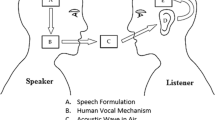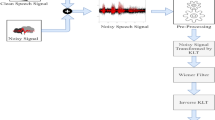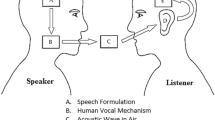Abstract
The tunable Q-factor-based wavelet transform (TQWT) is a novel method employed for the speech enhancement (SE) task. However, in TQWT, the controlling parameters Q-factor and the level of decomposition (J) are kept constant for different noise conditions which deteriorates the overall performance of SE. Generally, the performance of SE is calculated in terms of quality and intelligibility. However, it has been reported that these two evaluation parameters do not always correlate with each other because of the distortions introduced by the SE algorithms. These two important issues are addressed in this paper, and satisfactory solutions are provided by employing a multi-objective formulation to find the optimal values of the Q and J of the TQWT algorithm at different noise levels. In addition, to correctly estimate the appropriate values of Q and J from the unknown noisy speech, a low complexity functional link artificial neural network-based model is developed in this paper. To assess the performance of the proposed hybrid approach, subjective and objective evaluation tests are carried out using three standard noisy speech data sets. The results of the study are computed with six recently reported SE methods. It is demonstrated that in both the subjective and objective evaluation tests, the proposed hybrid approach outperforms the other six SE methods.






















Similar content being viewed by others
Data Availability
Data used in this proposed algorithm will be made available on request to the corresponding author.
References
S. Ayat, M.T. Manzuri, R. Dianat, Wavelet based speech enhancement using a new thresholding algorithm, in Proceedings of 2004 International Symposium on Intelligent Multimedia, Video and Speech Processing, pp. 238–241 (2004)
M. Bahoura, J. Rouat, Wavelet speech enhancement based on time-scale adaptation. Speech Commun. 48(12), 1620–1637 (2006)
J. Benesty, Fundamentals of Speech Enhancement (Springer, Berlin, 2018)
A. Bhowmick, M. Chandra, Speech enhancement using voiced speech probability based wavelet decomposition. Comput. Electr. Eng. 62, 706–718 (2017)
A. Bhowmick, M. Chandra, A. Biswas, Speech enhancement using Teager energy operated ERB-like perceptual wavelet packet decomposition. Int. J. Speech Technol. 20(4), 813–827 (2017)
B. Carnero, A. Drygajlo, Perceptual speech coding and enhancement using frame-synchronized fast wavelet packet transform algorithms. IEEE Trans. Signal Process. 47(6), 1622–1635 (1999)
J. Chen, J. Benesty, Y. Huang, E.J Diethorn, Fundamentals of Noise Reduction. In: Benesty J., Sondhi M.M., Huang Y.A. (eds) Springer Handbook of Speech Processing. Springer Handbooks. Springer, Berlin, Heidelberg (2008). https://doi.org/10.1007/978-3-540-49127-9_43
S.H. Chen, J.F. Wang, Speech enhancement using perceptual wavelet packet decomposition and Teager energy operator. J. VLSI Signal Process. Syst. Signal Image Video Technol. 36(2–3), 125–139 (2004)
C.A.C. Coello, G.B. Lamont, D.A.V. Veldhuizen et al., Evolutionary Algorithms for Solving Multi-Objective Problems, vol. 5 (Springer, Berlin, 2007)
C.C. Coello, M.S. Lechuga, MOPSO: A proposal for multiple objective particle swarm optimization, in Proceedings of the 2002 Congress on Evolutionary Computation. CEC’02 (Cat. No. 02TH8600), vol. 2, pp. 1051–1056 (2002)
K. Daqrouq, I.N. Abu-Isbeih, O. Daoud, E. Khalaf, An investigation of speech enhancement using wavelet filtering method. Int. J. Speech Technol. 13(2), 101–115 (2010)
T.K. Dash, S.S. Solanki, Investigation on the effect of the input features in the noise level classification of noisy speech. J. Sci. Ind. Res. 78(12), 868–872 (2019)
T.K. Dash, S.S. Solanki, G. Panda, Improved phase aware speech enhancement using bio-inspired and ANN techniques. Analog Integr. Circ. Sig. Process 102, 465–477 (2020)
T.K. Dash, S.S. Solanki, G. Panda et al. Development of statistical estimators for speech enhancement using multi-objective grey wolf optimizer. Evol. Intel. 14, 767–778 (2021). https://doi.org/10.1007/s12065-020-00446-0
C.S. Doire, M. Brookes, P.A. Naylor, C.M. Hicks, D. Betts, M.A. Dmour, S.H. Jensen, Single-channel online enhancement of speech corrupted by reverberation and noise. IEEE/ACM Trans. Audio Speech Lang. Process. 25(3), 572–587 (2017)
D.L. Donoho, De-noising by soft-thresholding. IEEE Trans. Inf. Theory 41(3), 613–627 (1995)
D.L. Donoho, J.M. Johnstone, Ideal spatial adaptation by wavelet shrinkage. Biometrika 81(3), 425–455 (1994)
J.S. Garofolo, L.F. Lamel, W.M. Fisher, J.G. Fiscus, D.S. Pallett, DARPA TIMIT acoustic-phonetic continuous speech corpus CD-ROM. NIST speech disc 1-1.1. NASA STI/Recon technical report n 93 (1993)
D. Giannoulis, M. Massberg, J.D. Reiss, Digital dynamic range compressor design—a tutorial and analysis. J. Audio Eng. Soc. 60(6), 399–408 (2012)
M.M. Goodwin, The STFT, Sinusoidal Models, and Speech Modification. In: Benesty J., Sondhi M.M., Huang Y.A. (eds) Springer Handbook of Speech Processing. Springer Handbooks. Springer, Berlin, Heidelberg (2008). https://doi.org/10.1007/978-3-540-49127-9_12
V. Grancharov, W. Kleijn, Speech Quality Assessment. In: J. Benesty, M.M. Sondhi, Y.A. Huang (eds) Springer Handbook of Speech Processing. Springer Handbooks. Springer, Berlin, Heidelberg. (2008). https://doi.org/10.1007/978-3-540-49127-9_5
G. Grindlay, Blind Dereverberation of Audio Signals. E4810 Final Project, University of Columbia (2008)
H.G. Hirsch, D. Pearce, The Aurora experimental framework for the performance evaluation of speech recognition systems under noisy conditions, in ASR2000-Automatic Speech Recognition: Challenges for the new Millenium ISCA Tutorial and Research Workshop (ITRW) (2000)
Y. Hu, P.C. Loizou, Speech enhancement based on wavelet thresholding the multitaper spectrum. IEEE Trans. Speech Audio Process. 12(1), 59–67 (2004)
Y. Hu, P.C. Loizou, Evaluation of objective measures for speech enhancement, in Ninth International Conference on Spoken Language Processing (2006)
Y. Hu, P.C. Loizou, Evaluation of objective quality measures for speech enhancement. IEEE Trans. Audio Speech Lang. Process. 16(1), 229–238 (2007)
Y. Hu, P.C. Loizou, Evaluation of objective quality measures for speech enhancement. IEEE Trans. Audio Speech Lang. Process. 16(1), 229–238 (2008)
J. Indra, R.K. Shankar, N. Kasthuri, S.G. Manjuri, A modified tunable-Q wavelet transform approach for tamil speech enhancement. IETE J. Res. 5, 1–14 (2020)
M.S. Islam, T.H.A. Mahmud, W.U. Khan, Z. Ye, Supervised single channel speech enhancement based on stationary wavelet transforms and non-negative matrix factorization with concatenated framing process and subband smooth ratio mask. J. Signal Process. Syst. 92(4), 445–458 (2020)
M.T. Islam, C. Shahnaz, W.P. Zhu, M.O. Ahmad, Speech enhancement based on student \(t\) modeling of Teager energy operated perceptual wavelet packet coefficients and a custom thresholding function. IEEE/ACM Trans. Audio Speech Langu. Process. 23(11), 1800–1811 (2015)
M. Jeub, M. Jeub (2020) Blind Reverberation Time Estimation (https://www.mathworks.com/matlabcentral/fileexchange/35740-blind-reverberation-time-estimation). MATLAB Central File Exchange. https://www.mathworks.com/matlabcentral/fileexchange/35740-blind-reverberation-time-estimation
M.T. Johnson, X. Yuan, Y. Ren, Speech signal enhancement through adaptive wavelet thresholding. Speech Commun. 49(2), 123–133 (2007)
J. Kennedy, Particle swarm optimization, Encyclopedia Mach. Learning (2010) 4, 760–766
K. Khaldi, A.O. Boudraa, A. Bouchikhi, M.T.H. Alouane, Speech enhancement via EMD. EURASIP J. Adv. Signal Process. 2008(1), 873204 (2008)
B.K. Khonglah, A. Dey, S.M. Prasanna, Speech enhancement using source information for phoneme recognition of speech with background music. Circuits Syst. Signal Process. 38(2), 643–663 (2019)
U. Kjems, J.B. Boldt, M.S. Pedersen, T. Lunner, D. Wang, Role of mask pattern in intelligibility of ideal binary-masked noisy speech. J. Acousti. Soc. Am. 126(3), 1415–1426 (2009)
A. Lerch, An Introduction to Audio Content Analysis: Applications in Signal Processing and Music Informatics (Wiley-IEEE Press, New York, 2012)
Z.X. Li, L.R. Dai, Y. Song, I. McLoughlin, A conditional generative model for speech enhancement. Circuits Syst. Signal Process. 37(11), 5005–5022 (2018)
P. Loizou, NOIZEUS: a noisy speech corpus for evaluation of speech enhancement algorithms. Speech Commun. 49, 588–601 (2007)
P.C. Loizou, Speech Enhancement: Theory and Practice (CRC Press, Cambridge, 2007)
P.C. Loizou, Speech Quality Assessment. In: W. Lin, D. Tao, J. Kacprzyk, Z. Li , E. Izquierdo, H. Wang (eds) Multimedia Analysis, Processing and Communications. Studies in Computational Intelligence, vol 346. Springer, Berlin, Heidelberg (2011). https://doi.org/10.1007/978-3-642-19551-8_23
P.C. Loizou, G. Kim, Reasons why current speech-enhancement algorithms do not improve speech intelligibility and suggested solutions. IEEE Trans. Audio Speech Lang. Process. 19(1), 47–56 (2011)
H. Löllmann, E. Yilmaz, M. Jeub, P. Vary, An improved algorithm for blind reverberation time estimation, in Proceedings of International Workshop on Acoustic Echo and Noise Control (IWAENC), pp. 1–4 (2010)
C.T. Lu, H.C. Wang, Enhancement of single channel speech based on masking property and wavelet transform. Speech Commun. 41(2–3), 409–427 (2003)
J. Ma, P.C. Loizou, SNR loss: a new objective measure for predicting the intelligibility of noise-suppressed speech. Speech Commun. 53(3), 340–354 (2011)
R. Majhi, G. Panda, G. Sahoo, Development and performance evaluation of FLANN based model for forecasting of stock markets. Expert Syst. Appl. 36(3), 6800–6808 (2009)
P. Malathi, G.R. Suresh, M. Moorthi et al. Speech Enhancement via Smart Larynx of Variable Frequency for Laryngectomee Patient for Tamil Language Syllables Using RADWT Algorithm. Circuits Syst Signal Process 38, 4202–4228 (2019). https://doi.org/10.1007/s00034-019-01055-8
H. Mofid, H. Jazayeri-Rad, M. Shahbazian, A. Fetanat, Enhancing the performance of a parallel nitrogen expansion liquefaction process (NELP) using the multi-objective particle swarm optimization (MOPSO) algorithm. Energy 172, 286–303 (2019)
S.J. Nanda, G. Panda, A survey on nature inspired metaheuristic algorithms for partitional clustering. Swarm Evolut. Comput. 16, 1–18 (2014)
A. Nishad, R.B. Pachori, Instantaneous fundamental frequency estimation of speech signals using tunable-\(Q\) wavelet transform, in 2018 International Conference on Signal Processing and Communications (SPCOM), pp. 157–161 (2018)
K.K. Paliwal, L. Alsteris, Usefulness of phase in speech processing, in Proceedings IPSJ Spoken Language Processing Workshop, Gifu, Japan, pp. 1–6 (2003)
Y.H. Pao, Adaptive pattern recognition and neuralnetwork. Addison-Wesley Publishing Company Int.; 1989
J.C. Patra, R.N. Pal, B.N. Chatterji, G. Panda, Identification of nonlinear dynamic systems using functional link artificial neural networks. IEEE Trans. Syst. Man Cybernet. Part B (cybernet) 29(2), 254–262 (1999)
P.M. Pradhan, G. Panda, Connectivity constrained wireless sensor deployment using multiobjective evolutionary algorithms and fuzzy decision making. Ad Hoc Netw. 10(6), 1134–1145 (2012)
L.R. Rabiner, R.W. Schafer, Digital Processing of Speech Signals, vol. 100 (Prentice-Hall, Englewood Cliffs, 1978)
I.T. Recommendation, Perceptual evaluation of speech quality (PESQ): An objective method for end-to-end speech quality assessment of narrow-band telephone networks and speech codecs. Rec. ITU-T P. 862 (2001)
Y. Ren, M.T. Johnson, J. Tao, Perceptually motivated wavelet packet transform for bioacoustic signal enhancement. J. Acoust. Soc. Am. 124(1), 316–327 (2008)
C.O. Sakar, G. Serbes, A. Gunduz, H.C. Tunc, H. Nizam, B.E. Sakar, M. Tutuncu, T. Aydin, M.E. Isenkul, H. Apaydin, A comparative analysis of speech signal processing algorithms for Parkinson’s disease classification and the use of the tunable Q-factor wavelet transform. Appl. Soft Comput. 74, 255–263 (2019)
I.W. Selesnick, Resonance-based signal decomposition: a new sparsity-enabled signal analysis method. Sig. Process. 91(12), 2793–2809 (2011)
I.W. Selesnick, Wavelet transform with tunable Q-factor. IEEE Trans. Signal Process. 59(8), 3560–3575 (2011)
G.L. Sicuranza, A. Carini, A generalized FLANN filter for nonlinear active noise control. IEEE Trans. Audio Speech Lang. Process. 19(8), 2412–2417 (2011)
R. Soleymani, I.W. Selesnick, D.M. Landsberger, SEDA: a tunable Q-factor wavelet-based noise reduction algorithm for multi-talker babble. Speech Commun. 96, 102–115 (2018)
C. Stedman, A matlab implementation of an audio compressor (2012), 2123–8227, http://hdl.handle.net/2123/8227
C.M. Stein, Estimation of the mean of a multivariate normal distribution. Ann. Stat. 5, 1135–1151 (1981)
C.H. Taal, R.C. Hendriks, R. Heusdens, J. Jensen, A short-time objective intelligibility measure for time-frequency weighted noisy speech, in 2010 IEEE International Conference on Acoustics, Speech and Signal Processing, pp. 4214–4217 (2010)
D.S. Trigueros, L. Meng, M. Hartnett, Face recognition: From traditional to deep learning methods. arXiv preprint arXiv:1811.00116 (2018)
T. Tuncer, S. Dogan, U.R. Acharya, Automated accurate speech emotion recognition system using twine shuffle pattern and iterative neighborhood component analysis techniques. Knowl. Based Syst. 211, 106547 (2021)
A. Varga, H.J. Steeneken, Assessment for automatic speech recognition: II. NOISEX-92: a database and an experiment to study the effect of additive noise on speech recognition systems. Speech Commun. 12(3), 247–251 (1993)
E. Vincent, MUSHRAM: a MATLAB interface for MUSHRA listening tests. http://www.elec.qmul.ac.uk/people/emmanuelv/mushram (2005)
W.D. Voiers, Interdependencies among measures of speech intelligility and speech Quality, in ICASSP’80. IEEE International Conference on Acoustics, Speech, and Signal Processing, vol. 5, pp. 703–705 (1980)
E. Wan, A. Nelson, R. Peterson, Speech enhancement assessment resource (SPEAR) database. CSLU, Oregon Graduate Institute of Science and Technology, Beta version Release v1. 0 (2002)
L. Wang, A. Cavallaro, “Deep Learning Assisted Time-Frequency Processing for Speech Enhancement on Drones”, in IEEE Transactions on Emerging Topics in Computational Intelligence, https://doi.org/10.1109/TETCI.2020.3014934.
Y.H. Wang, C.H. Yeh, H.W.V. Young, K. Hu, M.T. Lo, On the computational complexity of the empirical mode decomposition algorithm. Physica A 400, 159–167 (2014)
Y. Xi, L. Bing-wu, Y. Fang, Speech enhancement using bionic wavelet transform and adaptive threshold function, in 2010 Second International Conference on Computational Intelligence and Natural Computing, vol. 1, pp. 265–268 (2010)
A. Zeinalzadeh, Y. Mohammadi, M.H. Moradi, Optimal multi objective placement and sizing of multiple DGs and shunt capacitor banks simultaneously considering load uncertainty via MOPSO approach. Int. J. Electr. Power Energy Syst. 67, 336–349 (2015)
Y. Zhao, B. Xu, R. Giri, T. Zhang, Perceptually guided speech enhancement using deep neural networks, in 2018 IEEE International Conference on Acoustics, Speech and Signal Processing (ICASSP), pp. 5074–5078 (2018)
N. Zheng, X.L. Zhang, Phase-aware speech enhancement based on deep neural networks. IEEE/ACM Trans. Audio Speech Lang. Process. 27(1), 63–76 (2018)
G. Zhong, L.N. Wang, X. Ling, J. Dong, An overview on data representation learning: from traditional feature learning to recent deep learning. J. Finance Data Sci. 2(4), 265–278 (2016)
U. Zölzer, Digital Audio Signal Processing (Wiley, New York, 2008)
Author information
Authors and Affiliations
Corresponding author
Additional information
Publisher's Note
Springer Nature remains neutral with regard to jurisdictional claims in published maps and institutional affiliations.
Rights and permissions
About this article
Cite this article
Dash, T.K., Solanki, S.S. & Panda, G. Multi-objective Approach to Speech Enhancement Using Tunable Q-Factor-based Wavelet Transform and ANN Techniques. Circuits Syst Signal Process 40, 6067–6097 (2021). https://doi.org/10.1007/s00034-021-01753-2
Received:
Revised:
Accepted:
Published:
Issue Date:
DOI: https://doi.org/10.1007/s00034-021-01753-2




